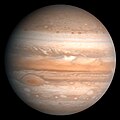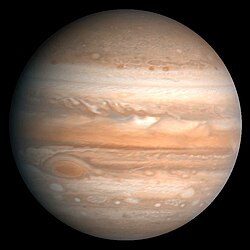Voyager 2

Voyager 2 er en del af NASA's Voyager rumprogram og havde sammen med Voyager 1 det formål at studere de yderligt liggende planeter i vores solsystem.
Voyager 2 blev opsendt den 20. august 1977 fra Cape Canaveral i Florida, 16 dage før Voyager 1. Voyager 2 nåede Jupiter, som var dens første mål på rejsen. Den 9. juli 1979 , ankom Voyager 1 faktisk til Jupiter 4 måneder før. Efter Jupiter fortsatte Voyager 2 til Saturn, Uranus og Neptun og det er det eneste rumfartøj der har besøgt de sidste to planeter.
Voyager 2 klarede derfor sin primære mission om at nå ud til det jovianske system[1] i 1979. I 1981 nåede den ud til Saturns system[2]. I 1986 nåede den ud til Uranus' system og i 1989, nåede den endelig Neptuns system.
Voyager 2 fortsætter mod udkanten af solsystemet ,og man regner med at den kan blive ved med at sende data tilbage til Jorden indtil 2025[3][4] December 2018 nåede Voyager 2 interstellart rum.[5]
Per oktober 2024 har Voyager 2 været afsted på sin mission i lidt mere end 47 år. Den 15. oktober 2024 befandt den sig lidt mere end 20 milliarder kilometer fra solen og radiosignalerne tog lidt mere end 19 timer at nå frem.[6]
Voyager 2 begav sig ud i interstellart rum d. 5. november 2018. Det vil sige at den har forladt Solens heliosfære og rejser igennem det interstellare rum.
Referencer
- ^ Gaskæmpe
- ^ Exploration of Saturn - Wikipedia
- ^ Voyager – the interstellar mission hentet d. 27. nov. 2009 (engelsk)
- ^ Vores fjernest rumsonde sender ubrugelige data hjem Arkiveret 24. maj 2010 hos Wayback Machine Ingeniøren
- ^ 11 december 2018, videnskab.dk: Efter 41 års rejse: NASAs Voyager 2 er nu nået til rummet mellem stjernerne, backup
- ^ Voyager 1 and Voyager 2 - Where Are They Now?
Henvisninger
| Spire Denne artikel om rumfart er en spire som bør udbygges. Du er velkommen til at hjælpe Wikipedia ved at udvide den. |
Medier brugt på denne side
A drawing of NASA's Space Shuttle Challenger. Image provided by Dryden Flight Research Center at Edwards Air Force Base, California. See [1], specifically EG-0076-04.eps.
The NASA/ESA Hubble Space Telescope has provided images of Saturn in many colors, from black-and-white, to orange, to blue, green, and red. But in this picture, image processing specialists have worked to provide a crisp, extremely accurate view of Saturn, which highlights the planet's pastel colors. Bands of subtle color (yellows, browns, grays) distinguish differences in the clouds over Saturn, the second largest planet in the solar system.
Saturn's high-altitude clouds are made of colorless ammonia ice. Above these clouds is a layer of haze or smog, produced when ultraviolet light from the sun shines on methane gas. The smog contributes to the planet's subtle color variations. One of Saturn's moons, Enceladus, is seen casting a shadow on the giant planet as it passes just above the ring system.
The flattened disk swirling around Saturn is the planet's most recognizable feature, and this image displays it in sharp detail. This is the planet's ring system, consisting mostly of chunks of water ice. Although it appears as if the disk is composed of only a few rings, it actually consists of tens of thousands of thin ringlets. This picture also shows the two classic divisions in the ring system. The narrow Encke Gap is nearest to the disk's outer edge; the Cassini division, is the wide gap near the center.Original Caption Released with Image: This processed color image of Jupiter was produced in 1990 by the U.S. Geological Survey from a Voyager 2 image captured in 1979. The colors have been enhanced to bring out detail. Zones of light-colored, ascending clouds alternate with bands of dark, descending clouds. The clouds travel around the planet in alternating eastward and westward belts at speeds of up to 540 kilometers per hour. Tremendous storms as big as Earthly continents surge around the planet. The Great Red Spot (oval shape toward the lower-left) is an enormous anticyclonic storm that drifts along its belt, eventually circling the entire planet.
The Voyager 2 aboard Titan III-Centaur launch vehicle lifted off on August 20, 1977. The Voyager 2 is a scientific satellite that studied outer planets Jupiter, Saturn, Uranus, and Neptune.





